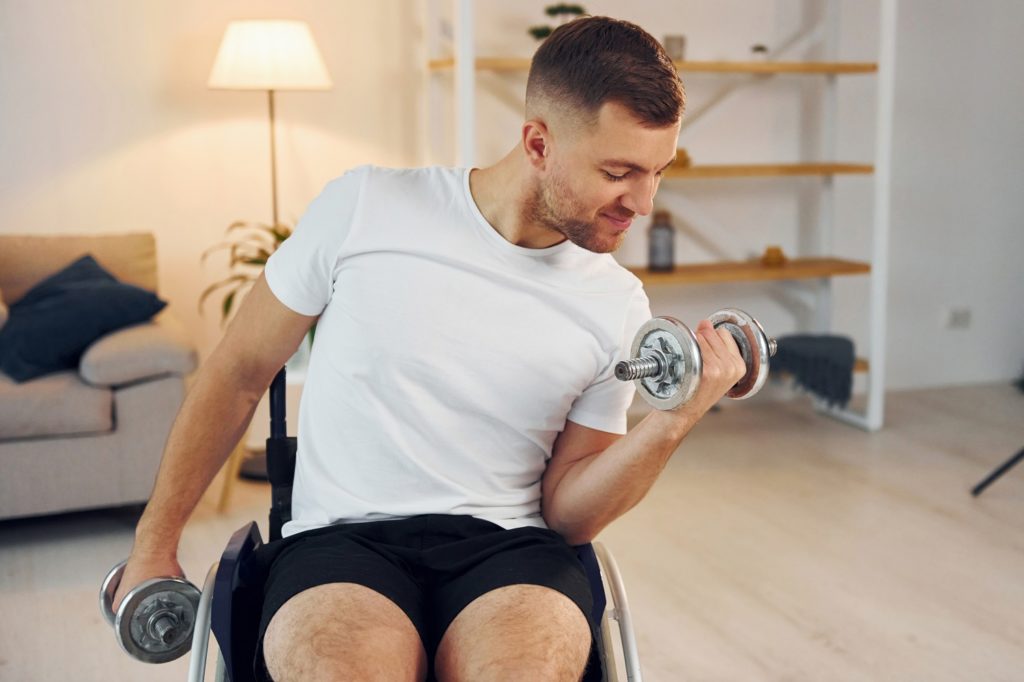Fitness and exercise are for everyone, no matter someone’s ability level or range of mobility. If you are experiencing limited or reduced mobility, you don’t have to give up on fitness and the benefits of exercise! Whether you’ve been living with limited mobility for a while or are newly adjusting, there are many great exercises and exercise modifications you can do to stay active, relieve stress, and boost your mood—let’s go over eight of our favorites. Remember, it’s always important to stretch and warm up before exercising to help prevent injuries.
Seated Twists
Seated twists are a great way to stretch out tight muscles, get the blood flowing, and work out your abdomen while sitting in a chair. You can choose to do this with or without a medicine ball held close to your chest. With your back straight and shoulders back, slowly twist your torso to the right until you feel a slight stretch. Then, return to the middle, and repeat to the left. You can do this exercise for a specific amount of time or a specific amount of reps—whichever you prefer.
Don’t twist too far or force extra reps! If you experience pain while doing this exercise, stop immediately.

Gentle Yoga or Stretching
Gentle yoga or stretching routines are wonderful for easing joint pain, working your core, and helping you relax. Find an instructor with low-impact routines you can follow, or choose a few yoga stretches you would like to tentatively try. As you are able, hold each stretch for about 20-30 seconds without pain or discomfort. Again, if you experience pain while doing this exercise, there is no shame in stopping.
Chair Lifts
If you have limited leg mobility and want a simple workout for your arms, chair lifts are a good option. Chair lifts strengthen your back, core, and arms. Using a chair with arms, put your hands on the sides of the chair, push yourself up, hold, come back down, and repeat. Remember to be in control of your breathing! You can do this workout for a specific amount of time or a specific amount of reps.
Chair Stands
Chair stands are another chair-based exercise you can do at home. This simple, low-impact workout is great for working your legs without requiring much movement. Chair stands are essentially standing up from a seated position in a chair and then sitting back down again. You’ll likely want a chair with arms so you can use your arms for support if needed. Do these in reps of 10 if you can!
Dumbbell Exercises
Dumbbell exercises are an excellent option for working out your arms and upper body because they are versatile and low-impact. You don’t need the huge dumbbells from the gym to get a workout, nor do you need a lot of space! There are many different things you can do with dumbbells, such as curls, shoulder presses, and lateral raises. Another benefit of dumbbell exercises is that you can do many of them while standing or sitting in a chair.
Resistance Bands
Resistance bands are the perfect tool for a lot of people with limited mobility because they allow you to add some resistance for strength-building without adding the pressure of gravity. These versatile bands can be used for almost any muscle group and every level of ability.
Shadowboxing
Shadowboxing is a fun way to work your muscles at your own speed, increase coordination and balance, and relieve tension. You can shadowbox while standing and shifting your balance from one foot to another, or you can shadowbox while sitting down. Throw a few light punches in the air to get a feel for your balance and power. Be sure not to overextend your elbows or shoulders.
Water Aerobics and Swimming
Finally, water aerobics and swimming are wonderful ways to increase your heart rate, strengthen your muscles, and get in a good workout while being a low-impact activity. The buoyancy of water can also help ease joint pain! If limited mobility is causing pain or discomfort with another exercise, water aerobics can be an effective (and fun!) alternative.
To stay safe while exercising, be sure to stretch, warm up beforehand and cool down afterward, avoid exercising on a current injury, and stop exercising if you experience chest pain, shortness of breath, nausea, or lightheadedness.
Limited mobility exercises or exercise modifications are effective ways to stay active and healthy while experiencing limited mobility. If you are looking for more options or want a more structured approach to fitness, contact a local personal trainer or get a physical therapist referral from your primary care provider.